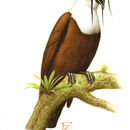en
names in breadcrumbs


Perception Channels: visual ; tactile ; acoustic ; chemical
Procnias tricarunculatus was once thought much more common than they actually are. This is because of their complex migratory patterns, with the same population being seen in different places. This bird is actually very threatened, due partly to hunting, and more importantly to deforestation. Even in Costa Rica, which has a well developed system of national parks and biological reserves, almost half of the country's forests have been cut down since 1940 (Wetmore 1972; Stap 2000).
US Federal List: no special status
CITES: no special status
IUCN Red List of Threatened Species: vulnerable
The three-wattled bellbird is very important to the survival of the Lauraceae tree. The bird, in fact, has been called by Daniel Wenny "far and away the most effective disperser of Lauraceae seeds." While eating, the bird flies back and forth between its favorite perches, spreading the seeds along the forest floor, away from the parent tree. Coincidently, their perches are often broken branches, allowing sunlight to reach the seeds and increase the chances of growth. This relationship is important for the overall health of Costa Rican forests specifically (Stap 2000).
Procnias tricarunculatus, like all bellbird species, is mostly frugivorous. Their favorite food is the wild avocado, of the Lauraceae tree. The trees and the birds rely heavily on each other for survival. The trees provide food for the species and in return, the birds are the primary disperser of their seeds (Stap 2000).
Three-wattled bellbirds are found from eastern Honduras to western Panama (Stap 2000).
Biogeographic Regions: neotropical (Native )
Three-wattled bellbirds breed in the highlands and migrate to the lowlands after breeding season. The lowlands, which they prefer, are suited for crops and are not protected by Costa Rican law. The highlands, which are more protected, consist of pine and deciduous forests, rainforests, and the bushy edges of forests (Ridgely 1976; Burton and Burton 1989).
Terrestrial Biomes: forest ; rainforest
The adult male is around 30.5 cm long. It has a chestnut brown body with a white head, neck, and chest. He has three worm-like wattles, one hanging from each side of the mouth, and one from the base of the bill. These are usually 5.1 to 7.6 cm long and a dark gray/black color. Immature males resemble the adult female but with short wattles.
The adult female is around 2.5 cm inches long and is mostly olive-green with a yellow underside streaked with dark olive-green. The female has no wattles (Ridgely 1976; Stap 2000).
Other Physical Features: endothermic ; bilateral symmetry
Procnias tricarunculatus breeds in the highlands (where it lives from March through September). After the breeding season it migrates to the lowlands (October through March). Much of the specific details of reproduction in P. tricarunculatus remains unstudied (Ridgely 1976).
Key Reproductive Features: iteroparous ; gonochoric/gonochoristic/dioecious (sexes separate); sexual ; oviparous